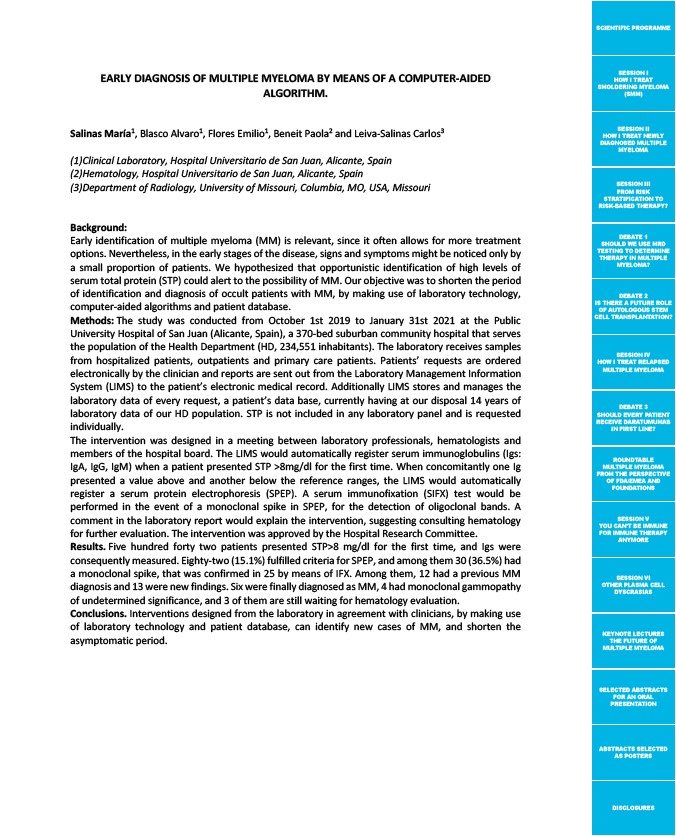
SCIENTIFIC PROGRAMME
SESSION I
HOW I TREAT
SMOLDERING MYELOMA
(SMM)
SESSION II
HOW I TREAT NEWLY
DIAGNOSED MULTIPLE
MYELOMA
SESSION III
FROM RISK
STRATIFICATION TO
RISK-BASED THERAPY?
DEBATE 1
SHOULD WE USE MRD
TESTING TO DETERMINE
THERAPY IN MULTIPLE
MYELOMA?
DEBATE 2
IS THERE A FUTURE ROLE
OF AUTOLOGOUS STEM
CELL TRANSPLANTATION?
SESSION IV
HOW I TREAT RELAPSED
MULTIPLE MYELOMA
DEBATE 3
SHOULD EVERY PATIENT
RECEIVE DARATUMUMAB
IN FIRST LINE?
ROUNDTABLE
MULTIPLE MYELOMA
FROM THE PERSPECTIVE
OF FDA/EMEA AND
FOUNDATIONS
SESSION V
YOU CAN’T BE IMMUNE
FOR IMMUNE THERAPY
ANYMORE
SESSION VI
OTHER PLASMA CELL
DYSCRASIAS
KEYNOTE LECTURES
THE FUTURE OF
MULTIPLE MYELOMA
SELECTED ABSTRACTS
FOR AN ORAL
PRESENTATION
ABSTRACTS SELECTED
AS POSTERS
DISCLOSURES
EARLY DIAGNOSIS OF MULTIPLE MYELOMA BY MEANS OF A COMPUTER-AIDED
ALGORITHM.
Salinas María1, Blasco Alvaro1, Flores Emilio1, Beneit Paola2 and Leiva-Salinas Carlos3
(1)Clinical Laboratory, Hospital Universitario de San Juan, Alicante, Spain
(2)Hematology, Hospital Universitario de San Juan, Alicante, Spain
(3)Department of Radiology, University of Missouri, Columbia, MO, USA, Missouri
Background:
Early identification of multiple myeloma (MM) is relevant, since it often allows for more treatment
options. Nevertheless, in the early stages of the disease, signs and symptoms might be noticed only by
a small proportion of patients. We hypothesized that opportunistic identification of high levels of
serum total protein (STP) could alert to the possibility of MM. Our objective was to shorten the period
of identification and diagnosis of occult patients with MM, by making use of laboratory technology,
computer-aided algorithms and patient database.
Methods: The study was conducted from October 1st 2019 to January 31st 2021 at the Public
University Hospital of San Juan (Alicante, Spain), a 370-bed suburban community hospital that serves
the population of the Health Department (HD, 234,551 inhabitants). The laboratory receives samples
from hospitalized patients, outpatients and primary care patients. Patients’ requests are ordered
electronically by the clinician and reports are sent out from the Laboratory Management Information
System (LIMS) to the patient’s electronic medical record. Additionally LIMS stores and manages the
laboratory data of every request, a patient’s data base, currently having at our disposal 14 years of
laboratory data of our HD population. STP is not included in any laboratory panel and is requested
individually.
The intervention was designed in a meeting between laboratory professionals, hematologists and
members of the hospital board. The LIMS would automatically register serum immunoglobulins (Igs:
IgA, IgG, IgM) when a patient presented STP >8mg/dl for the first time. When concomitantly one Ig
presented a value above and another below the reference ranges, the LIMS would automatically
register a serum protein electrophoresis (SPEP). A serum immunofixation (SIFX) test would be
performed in the event of a monoclonal spike in SPEP, for the detection of oligoclonal bands. A
comment in the laboratory report would explain the intervention, suggesting consulting hematology
for further evaluation. The intervention was approved by the Hospital Research Committee.
Results. Five hundred forty two patients presented STP>8 mg/dl for the first time, and Igs were
consequently measured. Eighty-two (15.1%) fulfilled criteria for SPEP, and among them 30 (36.5%) had
a monoclonal spike, that was confirmed in 25 by means of IFX. Among them, 12 had a previous MM
diagnosis and 13 were new findings. Six were finally diagnosed as MM, 4 had monoclonal gammopathy
of undetermined significance, and 3 of them are still waiting for hematology evaluation.
Conclusions. Interventions designed from the laboratory in agreement with clinicians, by making use
of laboratory technology and patient database, can identify new cases of MM, and shorten the
asymptomatic period.